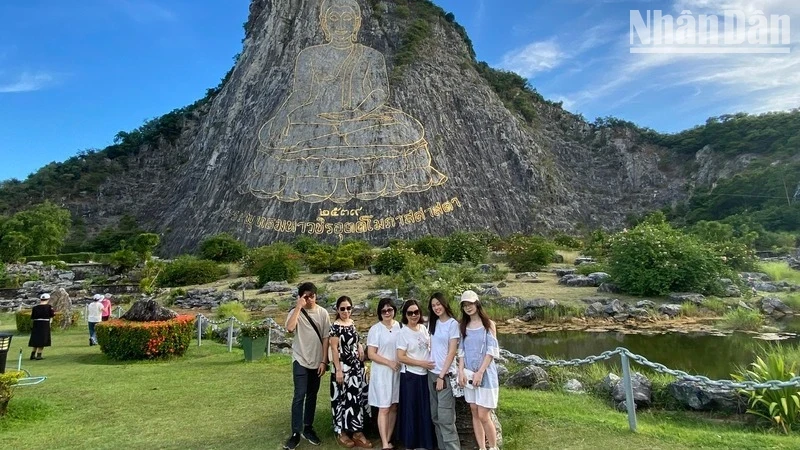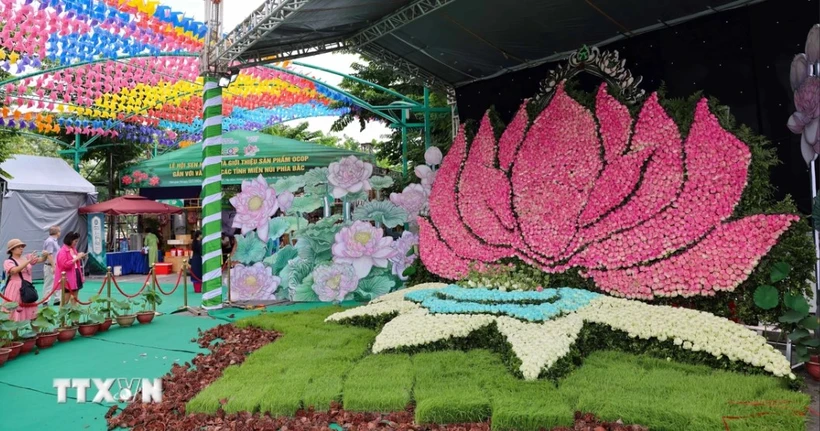 |
|
Vietnamese travelers to Thailand get 60-day visa free period. (Source: vov)
|
Along with the purpose of tourism, people from the qualified nations who enter Thailand temporarily for business, or for short-term work purposes, are also exempt from visa requirements.
Guests arriving from visa-exempt countries will also obtain a 30-day extension when necessary. However, their purpose of stay must be different from the first one and this must be accepted by relevant Thai authorities.
The decision took effect on July 15.
 |
| A group of Vietnamese tourists at Khao Chee Chan Golden Buddha Mountain, a tourist destination in Thailand, in June 2024. (Source: NDO) |
The Ministry of Tourism and Sports of Thailand revealed that in 2023 travelers from Vietnam were among the top 10 nationalities coming to Thailand, with over one million visits, equivalent to 96% of the 2019 figure.
Vietnam has advantages to attract Indian tourists: experts
Vietnam has advantages to attract more Indian tourists, according to experts. Data from the Vietnam National Authority of Tourism shows that before the COVID-19 pandemic, in 2019, Vietnam welcomed only 169,000 Indian visitors, reported VNA.
 |
| Indian tourists visit Bau Truc pottery village in the south central province of Ninh Thuan. (Photo: nhandan.vn) |
Meanwhile, last year, 392,000 Indian travellers arrived in Vietnam. In the first six months of 2024, the figure was 231,000, an increase of 164% over the same period in 2023.
Data from the Vietnam National Authority of Tourism shows that before the COVID-19 pandemic, in 2019, Vietnam welcomed only 169,000 Indian visitors. Meanwhile, last year, 392,000 Indian travellers arrived in Vietnam. In the first six months of 2024, the figure was 231,000, an increase of 164% over the same period in 2023.
India is among the top 10 largest source markets of Vietnam tourism. The report titled “Travel Trends 2024: Breaking Boundaries” by Mastercard's Economics Institute also affirmed Vietnam has emerged as a favoured international destination of Indian travellers.
The report said Indian outbound travel to Vietnam in the first three months of 2024 soared by 248% compared to 2019 levels.
According to experts, Vietnam has several advantages to further attract Indian travellers. Firstly, the distance between Vietnam and India is not too far as it takes about 4-5 hours to fly from India to Vietnam. Recently, more direct flights connecting the two countries have been operated.
In addition, Vietnam has competitive service prices, which are 10-15% cheaper than those in other countries in the region. Moreover, for many Indians, Vietnam is still a new destination with diverse culture, cuisine, and rich natural resources which inspire them to explore.
This helps explain why the number of Indian visitors to Vietnam has increased sharply in recent time, especially in places with rich tourism resources and high-quality infrastructure such as Da Nang, Phu Quoc, Ha Long, Hanoi, and Ho Chi Minh City.
Vietnam’s tourism industry has focused on promoting Vietnamese tourism to the Indian market.
Notably, Vietnam Airlines together with its partners of Vietravel, Vingroup, Sun Group and Indian travel agencies held an event to promote Vietnam tourism in New Delhi. They organised a series of events on the occasion of the launch of the Vietnam Tourism Information Centre in India, creating a bridge to more effectively exploit the world's most populous market.
According to experts, besides attracting Indian customers, an important issue is to develop services and products to satisfy demanding tourists.
Nguyen Quang Vinh from the Tourism Development Research Institute said Indian tourists often travel with families or groups of friends, rarely travel alone. They like shopping, outdoor activities, visiting museums and cultural and historical relics.
Vinh, who led a study on Indian tourists to Vietnam, said that Indian tourists prefer beautiful resorts and parties. They often choose to use services at the above-average level. They carefully plan for their trips and search relevant information online via portals and social networks.
So, digital promotion activities are effective to approach this tourist segment, Vinh said.
Associate Professor, Dr. Pham Hong Long, head of the Department of Tourism Studies at the University of Social Sciences and Humanities (Vietnam National University-Hanoi) said that although the number of Indian tourists to Vietnam are increasing, there are no specific and complete statistics on human resources serving Indian tourists.
It’s necessary to train and improve knowledge and skills for staff who serve Indian customers, he said.
Tourism research expert Nguyen Van Gia said that travel agencies need to coordinate closely with Indian partners to clarify guests' requirements regarding food and drink.
Gia said that State agencies need to support businesses in human resources training, particularly for tour guides, restaurant and hotel staff and staff of other service providers.
Vietnam should also cooperate with Indian partners in food processing and the supply of spices and raw materials to serve the dietary needs of Hindus and Muslims.
Success of Hanoi Lotus Festival opens up new prospects for capital’s tourism
According to VNA, Hanoi’s first-ever lotus festival, held from July 12-16 and participated by more than 50,000 visitors, was a great success, opening high prospects for the capital city to build a unique cultural and tourism brand.
 |
| A giant lotus shaped by 10,000 lotus flowers at the Hanoi Lotus Festival (Photo: VNA) |
Organised at the Cultural and Creative Space in Tay Ho district, the festival, which introduced OCOP (One Commune-One Product) products in association with the culture of northern mountainous localities, featured various culture, art, and trade activities.
Following an impressive opening ceremony was a diversity of activities, including an exhibition showcasing lotus-inspired art works, a photo contest, and a cycling event around Ho Tay (West Lake) that drew 7,000 cyclists.
Along Trinh Cong Son pedestrian street in Tay Ho district, many ornamental lotus pots with different species blooming were arranged, affirming Hanoi’s lotus brand and spotlighting the delicate hands of Hanoi lotus artisans.
The exhibition space introducing OCOP products of different northern localities and hundreds of kinds of lotus-based products became a highlight of the festival. It featured more than 100 booths from 33 provinces and cities that showcased over 1,000 products under their One Commune One Product programmes.
Many artisans, including Nguyen Cao Son and Luu Thi Hien, were also present to introduce the unique art of making and enjoying lotus tea of Hanoi people.
According to Hien, Tay Ho lotus tea is one of the specialties of Hanoi. Scented with Bac Diep lotus grown in some areas of the West Lake, Tay Ho lotus tea is handcrafted meticulously and delicately from the choosing ingredients to scenting, she said.
Most artisans who make Tay Ho lotus scented tea do not use modern technology to make it but still keep the manual method passed down from their ancestors, the artisan added.
The five-day festival was a success, leaving deep impressions among visitors.
According to the People’s Committee of Tay Ho district, the event saw a transaction value of 11 billion VND (433,523 USD), including more than 6 billion VND of direct sales.
Le Ba Dung, a visitor from Hoang Mai district of Hanoi, expressed his strong impression after enjoying Tay Ho lotus tea and talking to famous Hanoi tea artisans. Meanwhile, Nguyen Thu Huong, a resident of Tay Ho district, said that she is fascinated by many entertainment activities at the festival.
Currently, Hanoi has 600 hectares of lotus, mostly in Tay Ho, My Duc, Me Linh, and Thach That districts, providing great spaces for photo lovers, and materials for the production of handicraft and food products from lotus.
Many products under the One Commune – One Product (OCOP) programme have been developed from lotus, including silk scarf, Quang An tea, Me Linh tea, sausage, steamed sticky rice, longan sweet soup, jam, and milk, which have been exported to many countries around the world.
Vice Chairwoman of the People’s Committee of Tay Ho district Bui Thi Lan Phuong affirmed that after the success of the festival, the district will consider turning it into a regular event carrying the capital city’s tourism brand.
Indonesian famtrip delegation explores Da Nang
An Indonesian famtrip delegation comprising 35 representatives from various travel firms is currently paying a visit to the central city of Da Nang, reported VOV.
 |
| 35 representatives from Indonesian travel firms explore the central city of Da Nang (Photo: cadn.com.vn) |
The group plans to take time to explore a number of popular tourist destinations throughout the city, including Ba Na Hills, the Marble Mountains, the Cham Museum, and Hoi An Ancient Town in nearby Quang Nam province.
The farmtrip, co-organised by Da Nang Tourism Promotion Center and Hai Van Cat International Travel Joint Stock Company, aims to seek solutions to lure more Indonesian tourists to the area and accelerate the launch of flights from Indonesia to Da Nang which is scheduled to open in October.
The Indonesian delegation will also attend a Gala Dinner and meet with local firms to discuss tourism co-operation opportunities.
Indonesia is widely viewed as a potentially lucrative market as it boasts the fourth largest population in the world and the largest population in Southeast Asia with more than 280 million people, the majority of whom are Muslims.
Since 2023, Da Nang International Airport has put into use a prayer room to serve Muslim passengers, while several accommodation facilities in the city have also set up prayer rooms and introduced Muslim-friendly services.
In 2023, as many as 26,000 Indonesian tourists arrived in the central city, accounting for about 25% of the total number of Indonesian visitors to Vietnam./.